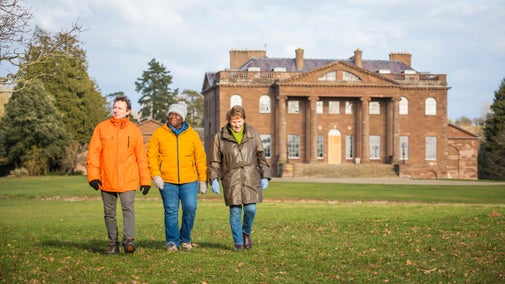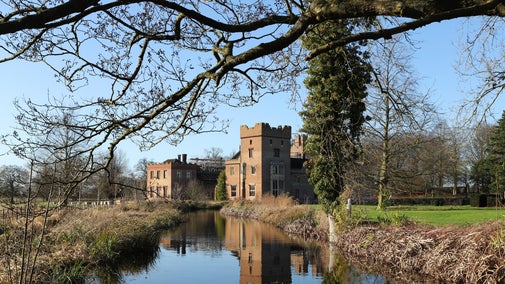Looking after Berrington Hall
- Last updated:
- 13 May 2023

Jump to
Essential improvement works are taking place at Berrington over the next few years. Discover more about our work, how you can get involved and how it might affect your visit.
Stonework restoration
Thanks to funds raised by our supporters, we’ve been able to begin vital restoration work to some elevations of the courtyard buildings. The work has largely involved removing shaling faces of stone which have been degrading and weathering over many years. The masonry blocks behind the outer layer remain sound.
The shaling faces will be restored on a stone-by-stone basis and any loose stone will be removed. The remaining face of the stone will be ‘dressed’ to a level surface. Where we need to replace stones, Hollington stone will be used, which will weather-in most effectively. This vital project will improve the visual appearance of the courtyard buildings, ensure the safety of the stone faces and mean that Berrington is conserved for generations to come.
When is the work happening?
The first phase of the project took place in September and October 2020 and involved a tower scaffold to access the upper parts of the courtyard buildings for ‘shaling’ work.
The second phase is a specialist, finishing stage undertaken by local stone masons which involves some scaffolding. This work is ongoing. During this phase of the renovation, please note that there will be some disruption around the Stables Café area. Access to the cafe and welcome centre will be via the courtyard, and there may be some noise and dust. We apologize for any inconvenience and thank you for your understanding as we work to preserve Berrington Hall for future generations.
Historical significance
Berrington Hall was saved for the nation in 1957 because it’s one of the few masterpieces of the famous architect Henry Holland to survive intact. The red sandstone exterior belies the delicacy of the neo-classical interiors; the almost complete survival of Holland’s internal scheme makes Berrington of international significance. This project is vital to ensure we continue to look after and preserve this special place for generations to come.
The three detached courtyard buildings were originally service wings, arranged around a formal court onto which some of the principal rooms face. Originally these wings would have housed the kitchen, laundries and servants’ hall. These are the areas that are having stonework restored as part of this project.
Thanks to Westminster Stone for their support and contribution to this project.

Biomass boiler
Here at Berrington Hall, we are aiming to reduce our carbon footprint to achieve net zero by 2030. One way in which we have been working to achieve this is by installing a biomass heating system, which will potentially reduce carbon emissions by 85 tonnes per year.
This project began in April 2022 with the installation of a building to house the new boiler. We are pleased to say that not only will the biomass be fuelled by woodchips taken from our places in Herefordshire, but that building itself is also clad in wood from National Trust Herefordshire estates.
As of April 2023, the biomass boiler has been connected to the wet system and has been providing heat to the ground floor of the mansion. We will soon begin replacing more electrical radiators with new radiators that can be connected to the biomass system. This is a very large project and will take several years to deliver.
The benefits of the biomass heating system include:
- Once complete Berrington’s Biomass should generate 386,851kWh of low-carbon heat.
- We will positively reduce carbon emissions by 85 tonnes per year (the same as would be absorbed by 42,500 trees).
- We will be able to generate over £11,000 of income per year from the government’s Renewable Heat Incentive (RHI) which will help us extend and install the supporting wet system over a yearly programme.
- All of the wood fuel we use will be from our woodland management work at our places in Herefordshire, which will also help us replant with mixed native broadleaf species to improve habitat and biodiversity long-term

The Garden Project
Berrington Hall is a set piece of 'Capability' Brown design and his final landscape masterpiece. Recent research into the walled garden and pleasure grounds has revealed the rarity and significance of this garden treasure and we’re working to conserve and reimagine it.
The Garden Project began in 2016 with archaeological research improving our understanding of the gardens and their original designs. These findings will be used along with Brown's designs to aid the new designs for the garden.
Restoring the Curve
An important part of the garden is the curved walled garden, or the ‘Curve’ as has become known, built in 1783 to Brown’s original design. It's the only one of its kind to survive the centuries and it is believed that the garden may have been used for growing exotic fruits like pineapples in forcing pits, a far cry from the 20th-century farm buildings it was used for by tenant farmers.
From November 2020 until March 2021, we carried out urgent repair work and conservation of the curved garden walls, carefully deconstructing the former farm buildings. This work was necessary to ensure the brickwork does not continue to deteriorate and that this internationally significant garden is preserved for generations to come.
In May 2022, restoration work began on the Carpenter’s Workshop which had fallen into disrepair. Since its redevelopment, the Carpenter’s Workshop has been used as an artist's studio, with workshops and exhibitions to inspire future experiences.
Community participation at Berrington
The Berrington garden project has been a fantastic opportunity to engage with the community, with several partnerships with local groups starting up.
Working alongside National Trust staff and volunteers, these groups have helped guide us with the garden plans, breathing new life into the different spaces around the garden. Over the years, these partnerships have delivered workshops, open studio sessions, and pop-up exhibitions to provide inspiration and ideas for future experiences within the Curve and walled garden at Berrington Hall.
The Garden Project is still ongoing, with more work to be done to restore, revive and reimagine these spaces for visitors.

Pool restoration
The pool was designed by ‘Capability’ Brown and, along with the parkland and garden, was his final complete estate before his death in 1783. The pool is a Site of Special Scientific Interest (SSSI) due to the large heronry which nests on the island every year.
Thanks to funding awarded from National Highways under the Environment and Wellbeing Designated fund, in 2021 we conducted vital restoration work on the pool at Berrington.
Why was the pool restored?
The pool was in urgent need of restoration; the biodiversity of the pool had been adversely affected over the years due to the spread of reed cover and increase in the silt bed. Large carp were the dominant fish species and predated on smaller fish which are a key food source for herons. Heron numbers had sadly declined over the last 10 years. It was therefore vital that we intervened to ensure the survival of the SSSI and the heronry.
What restoration work took place?
Restoration work began in November 2021, when the fish were removed from the pool. Native species of fish were kept in holding tanks to be returned to the pool and carp were rehomed. The pool was then drained of water and desilted over several months. A channel was also created around the island to allow water to circulate. Vegetation stopping the circulation of water was removed. Trees in Moreton Ride which were causing debris to accumulate in the pool were thinned.
The pool was then slowly refilled with rainwater. When the level was sufficient, native species of fish were reintroduced to the pool. These species include rudd, common roach, European perch and northern pike, all of which are a brilliant source of food for herons and other waterfowl.
What did we discover during the restoration?
The pool restoration project was a fantastic opportunity to understand what wildlife relies on the pool. Wildlife surveys conducted during the project revealed 35 different types of invertebrates present in the pool, as well as 38 species of bird including the great white egret, water rail, green sandpiper, and kingfisher. The footprints of an otter were also discovered whilst work was undertaken, suggesting that they also use the pool to source food.
What next?
Over time, the biological integrity of the pool will increase. We will continue controlling the tree cover and vegetation in and around the pool. Water samples from the pool will be tested regularly to identify whether the water quality has improved. The numbers of birds, and especially herons, will also be monitored and should indicate whether the restoration was successful.
Where silt has been deposited from the pool in Moreton Ride, we are going to work with ecologists to turn this into new habitats and further increase the biodiversity of Berrington’s parkland.

You might also be interested in
History of Berrington Hall
Uncover 230 years of history at Berrington Hall. It started as an escape to the country for a city banker and was ‘Capability’ Brown’s final landscape project.

The parkland at Berrington Hall
Explore Lancelot 'Capability' Brown's vision of stunning views and winding walking trails through acres of parkland at Berrington.

The garden at Berrington Hall
Berrington has an internationally significant garden. It’s the final landscape garden project completed by Lancelot ‘Capability’ Brown with a walled garden, traditional orchard, productive kitchen garden, curved garden and a brand new flower garden.

Our cause
We believe that nature, beauty and history are for everyone. That’s why we’re supporting wildlife, protecting historic sites and more. Find out about our work.
